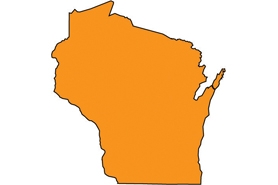Japanese barberry
(Berberis thunbergii)
A low-growing (2-3' tall), dense, spiny shrub with small oval green leaves that turn reddish-brown in fall. Plants have single sharp spines and small, bright red, oblong berries at each node.
Other names for this plant include:
- Common names: barberry, Thunberg's barberry, Japanese berberis
- Scientific names: Berberis thunbergii var. atropurpurea
Classification in Wisconsin: Restricted (this restriction only applies to the parent type, the variety atropurpurea, the hybrid of B. thunbergii x B. Koreana, and the following cultivars. Berberis thunbergii cultivars: Sparkle, ‘Anderson’ Lustre Green™, Erecta, ‘Bailgreen’ Jade Carousel®, Angel Wings, Painter’s Palette, Inermis (‘Thornless’), Pow Wow, Golden Ring, Kelleriis, Kobold, ‘JN Variegated’ Stardust™ and Antares. Variety atropurpurea cultivars: Marshall Upright (‘Erecta’), Crimson Velvet, ‘Bailtwo’ Burgundy Carousel®, Red Rocket, ‘Monomb’ Cherry Bomb™, ‘Bailone’ Ruby Carousel®, JN Redleaf, Rose Glow and Silver Mile. Hybrid of B. thunbergii x B. koreana cultivars: Tara and ‘Bailsel’ Golden Carousel®)
- Ecological Threat
-
- Shade tolerant, drought-resistant, and adaptable to various open and wooded habitats, wetlands, old fields and disturbed areas.
- It forms dense stands in natural habitats, dominating the forest understory by shading out native plants and changing the foraging habits of wildlife.
- Spreads vegetatively through horizontal branches that root freely when they touch the ground.
- Research shows infested forests have higher rates of Lyme disease-carrying ticks.
- White-tailed deer avoid browsing barberry due to the spines, preferring to feed on native plants, giving it a competitive advantage.
- Prefers well-drained soils and sunny habitats but will survive and produce fruit in even heavily shaded environments.
- Very invasive and widespread across the eastern United States and the midwest.
- Cultivars are widely planted as ornamentals.
- Identification
-
Leaves & stems: Clustered in tight bunches above spines, the leaves are simple, alternate, small, and oval to spatulate shaped (wider at the tip than the base). Leaves may be green, bluish-green or dark reddish-purple depending on the cultivar. They leaf out in early spring. Plants have single sharp spines at each node. If a stem is cut, it will reveal that the inner bark is yellow. Branches root freely when they touch the ground.
Flowers: Flowers are cream-yellow colored, bowl-shaped with notched edges, six petals, and small (1/3" wide). They occur individually or in small clusters of 2-4, blooming in mid-spring.
Fruits & seeds: Small, bright red, oblong berries occur on narrow stalks both singly or in clusters. Berries persist on shrubs into winter. Birds readily disperse seeds.
Roots: Creeping, shallow roots are tough. The Interior of the roots is yellow. Branches root freely when they come into contact with the ground.
Similar species: European barberry or common barberry (Berberis vulgaris) is also a non-native invasive (classified as Prohibited) but has spiny, toothed leaves and flowers in a long raceme.
- Control
- Mechanical:
- Plants can be pulled out or dug up, easiest in early spring. Remove all roots and watch for resprouts. Cutting without herbicide will result in resprouting.
- Mow or cut larger plants before seed set if not able to remove the entire plant.
- Prescribed burns in early spring or late fall can effectively kill seedlings. Use this method in fire-adapted communities to prevent the mortality of surrounding desired vegetation.
- Foliar spray with metsulfuron-methyl, triclopyr or glyphosate.
- Adding a penetrating oil can be effective when used as a cut-stump treatment and basal barking.
For more information on control techniques, visit the Japanese barberry factsheet [exit DNR] by the University of Wisconsin-Extension.
- Resources
- Sources for content:
- Czarapata, Elizabeth; Invasive Plants of the Upper Midwest: an illustrated guide to their identification and control. The University of Wisconsin Press. 2005. Pg. 88-89
- Center for Invasive Species and Ecosystem Health, Invasive.org. Japanese barberry [exit DNR].


